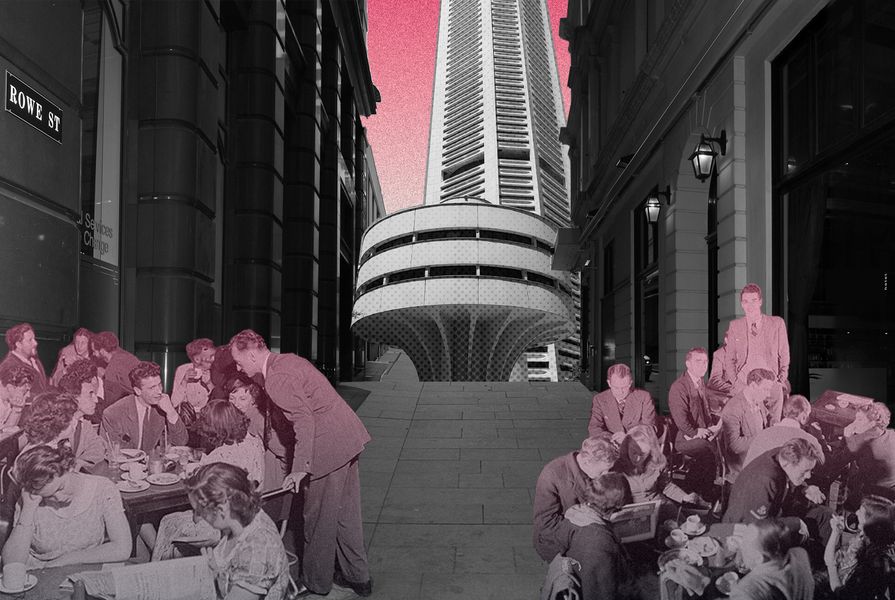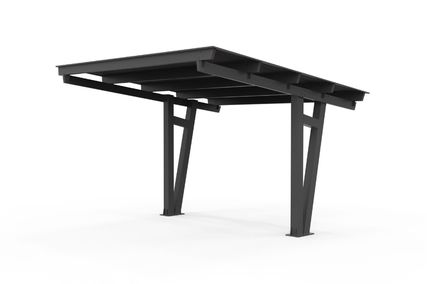The gold-leaf hand on the architrave points down. “Coffee,” declares the sign. “Teas.” But the night is dark and the door locked. The visitor raps out a special coded rhythm. A slot slides open and two eyes appear, narrow with suspicion. She utters a single word – the right word, apparently, for the door opens onto a descending wooden stair from which rises a cloud of smoke and booze and sweat and, above all, talk. In the far corner, a lanky folk singer strums Pete Seeger and at tables crowded with ashtrays, intense young people in shirtsleeves and floral dresses drink from mismatched china tea sets. Not tea, though. Beer, whisky and gin.
That was 70 years ago – the era of the speakeasy, well before my time. We think of the fifties as staid and repressive but – or perhaps therefore – it was also an era of resistance, rebellion, dissent. The human spirit demanded difference. It demanded an architecture of subculture.
Fast-forward to today, when the digital age throws up similar contradictions. The more atomized our culture becomes, for instance, the more homogenous our cities. Similarly, the more abstract our lives – so that a chat room, far from being sweaty and smoke-filled, isn’t a room at all but a collection of masked online avatars – the less capable we become of the mental abstraction required for civilized debate.
This suggests that, contrary to popular belief, our mental lives are still strongly conditioned by our physical experience. It should delight architects, since it puts spatial design at the centre not only of utilitarian existence but also of the shared belief system we call culture.
No doubt every era has its subcultures and every subculture has its venues. Think the opium dens of the 1890s, the brothels of the 1910s, the bohemian laneways of the 1930s, the speakeasies of the 1950s, the hippie inner-city shops and bars of the 1970s, the gay clubs of the 1990s and, even in the noughties, back lanes like mine in Redfern, where smack was dealt to hooded figures day and night from permanent private caravans. Go figure. Now, although there is no shortage of refusenik culture, these specialized ecological niches have been gentrified, sanitized, bulldozed and digitized almost out of existence.
True, there have been occasional attempts at reinstatement. For example, Sydney’s famous Rowe Street (which had the rare distinction of being named after a celebrated architect, Thomas Rowe 1829–1899) was a haven for European interwar émigré culture. It hummed with bohemian street life until the little galleries, printmakers, record shops, design establishments and milliners that furnished it were ruthlessly bulldozed in 1972 and replaced with the towering MLC Centre. In recent years, the City of Sydney has done its best to resuscitate the lane, but the result – devoid of its animating eccentrics – remains dismal and soulless.
Whoever said “build it and they will come” was missing something. Building isn’t enough. In this case, the intervening decades between demolition and reinstatement wrought such a vast reversal of social and economic patterns that the old life of Rowe Street, if it still existed, could not thrive downtown. After a hundred years, the modernist CBD nomenclature had won. The city was no longer a place for real, vivid human life but for suits. Bohemia be damned; “City” meant business.
The creatives who had once found shelter in downtown’s neglected crannies, crevices and crooked back-alleys were radially dispersed – first to the surrounding rust belt, then further afield, to the burbs. Two factors precluded any re-establishment of creative bohemia in these new locales. First, the geometry of dispersal meant that it was increasingly difficult to replicate the proximities of inner-city life. And second, new developer-led city-making patterns – be they suburban or, more recently, tower-and-motorway based – were without crevices. With no basement storerooms or disused attics to perch in, no dingy alleys to colonize, the frisson necessary for subcultural creation – like the hum of a zillion cicadas – stopped. The lesson? Spaces matter.
How, then, should our cities respond to the need for cultural pluralism? Is there a way to re-create the lost niches of our urban fabric?
First, we must consider the nature of subcultures. Some are non-threatening: a square-dancing group, book club or knitting circle. Broadly speaking, though, subcultures exist by virtue of dissent. They seek comfort in some flipside of orthodox culture, some underbelly. Defining themselves by exclusion – by what they are not – such groups thrive on a sense of recusancy, which in turn suggests a level of mystery and even secrecy.
The activity needn’t be illegal, like after-hours liquor in the days of the speakeasy. Gay culture thrived along Oxford Street and the Cross in the 1990s, well after homosexuality was legalized, because it maintained a sense of flamboyant difference from the mainstream. The end really came with the “lockout laws” in 2014, followed by COVID lockdowns and accompanied by (some might say playing into the hands of) unchecked inner-city gentrification. Mardi Gras may continue but the street-culture of “Darlo” has never revived – due in part, no doubt, to the increasing acceptance of gay culture that, although welcome, has erased the frisson of transgression that gave the clubs their flavour.
Or consider Cave Clan, a group of urban explorers founded in Melbourne in the 1980s, with a branch also in Sydney. After two Cave Clan explorers drowned in 2008, some 20 metres below ground in a flash flood in a Sydney stormwater drain known as “Fortress,” an anonymous clan member said it contravened his “urban explorer ethics” to give out any information to the media. This underground (literally) subculture retains its identity by sustaining the cloak of transgressive secrecy.
Which is why exercises like the City of Sydney’s current survey, intended to elicit the city’s future creative-space needs, are likely doomed to death-by-bureaucracy. Art is the attempt to reveal by non-rational means what we normally fail (or decline) to see. It looks around corners and under rocks, asking questions not generally countenanced. Inherently subversive (authorized art is rarely the interesting stuff), it cannot thrive in spaces that are fully lit, regulated, approved and leased from officialdom.
Subcultures require at least a sense of mystery, if not of transgression. To take root, they require a fabric not blown apart by towers and motorways, but veined with cracks and crevices. They require basements and attics, forgotten niches and shadowed corners; a degree of looseness from architectural typologies and acceptance from authorities; and a planning system that prefers enablement to control. If that means revolution, I say, bring it.
















